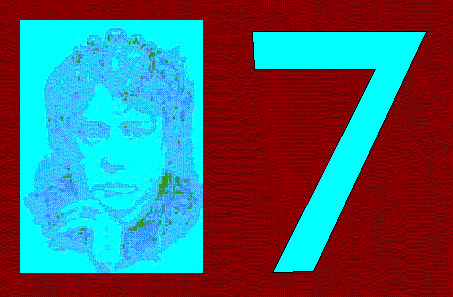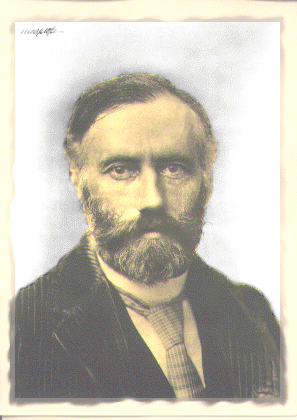Theosophy and the Number
Seven

A selection of articles
relating to the esoteric
significance
of the Number 7 in Theosophy
Septenary Constitution of Man
by
William Q. Judge
This is Chapter 4 of The Ocean of Theosophy

Respecting the nature of man there are two ideas current in the
religious
circles of
Christendom. One is the teaching and the other the common acceptation of it;
the first is not secret, to be sure, in the Church, but it is so seldom dwelt
upon in the hearing of the laity as to be almost arcane for the ordinary
person.
Nearly everyone says he has a soul and a body, and there it
ends. What
the soul is,
and whether it is the real person or whether it has any powers of
its own, are
not inquired into, the preachers usually confining themselves to
its salvation
or damnation. And by thus talking of it as something different
from oneself,
the people have acquired an underlying notion that they are not
souls because
the soul may be lost by them. From this has come about a tendency to
materialism causing men to pay more attention to the body than to the soul, the
latter being left to the tender mercies of the priest of the Roman
Catholics, and among dissenters the care of it is most
frequently put off to the
dying day. But
when the true teaching is known it will be seen that the care of
the soul, which
is the Self, is a vital matter requiring attention every day,
and not to be
deferred without grievous injury resulting to the whole man, both
soul and body.
The Christian teaching, supported by St. Paul, since upon him,
in fact, dogmatic
Christianity rests, is that man is composed of body, soul, and
spirit. This is
the threefold constitution of man, believed by the theologians
but kept in the
background because its examination might result in the readoption of views once
orthodox but now heretical. For when we thus place soul between
spirit and body, we come very close to the necessity for looking into the
question of the soul's responsibility -- since mere body can have no
responsibility. And in order to make the soul responsible for the acts
performed, we must assume that it has
powers and functions.
From this it is easy to take the position that the soul may be
rational or irrational, as the Greeks sometimes thought, and then there is but
a step to further Theosophical propositions. This threefold scheme of the
nature of man contains, in fact, the Theosophical teaching of his sevenfold
constitution, because the four other divisions missing from the category can be
found in the powers and functions of body and soul, as I shall attempt to show
later on.
This conviction that man is a septenary
and not merely a duad, was
held long ago and very plainly taught to every one with
accompanying
demonstrations, but like other philosophical tenets it
disappeared from sight,
because gradually
withdrawn at the time when in the east of Europe morals were
degenerating and
before materialism had gained full sway in company with
scepticism, its
twin. Upon its withdrawal the present dogma of body, soul,
spirit, was left to Christendom. The reason for that concealment
and its
rejuvenescence in this
century is well put by Mme. H. P. Blavatsky in the Secret
Doctrine. In answer to the statement, "we cannot understand
how any danger could arise from the revelation of such a purely philosophical
doctrine as the
evolution of the planetary chain," she says:
The danger was this: Doctrines such as the Planetary chain or
the seven races
at once give a clue to the seven-fold nature of man, for each
principle is
correlated to a plane, a planet, and a race; and the human
principles are, on
every plane, correlated to seven-fold occult forces -- those of
the higher
planes being of tremendous occult powers, the abuse of which
would cause
incalculable evil to humanity. A clue, which is, perhaps, no
clue to the
present generation -- especially the Westerns -- protected as
they are by
their very blindness and ignorant materialistic disbelief in the
occult; but a
clue which would, nevertheless, have been very real in the early
centuries of
the Christian era, to people fully convinced of the reality of
occultism, and
entering a cycle of degradation, which made them rife [ripe] for
abuse of
occult powers and sorcery of the worst description.
Mr. A. P. Sinnett, at one time an official in the Government of
India, first
outlined in this century the real nature of man in his book
Esoteric Buddhism,
which was made up from information conveyed to him by H. P.
Blavatsky directly from the Great Lodge of Initiates to which reference has
been made. And in thus placing the old doctrine before western civilization he
conferred a great benefit on his generation and helped considerably the cause
of Theosophy.
His
classification was:-
The Body, or Rupa.
Vitality, or
Prana-Jiva.
Astral Body,
or Linga-Sarira.
Animal Soul,
or Kama-Rupa.
Human Soul,
or Manas.
Spiritual
Soul, or Buddhi.
Spirit, or
Atma.
The words in italics being equivalents in the Sanskrit language
adopted by him
for the English terms. This classification stands to this day
for all practical
purposes, but it is capable of modification and extension. For
instance, a later
arrangement which places Astral body second instead of third in
the category
does not substantially alter it. It at once gives an idea of what
man is, very
different from the vague description by the words "body and
soul," and also
boldly challenges the materialistic conception that mind is the
product of
brain, a portion of the body. No claim is made that these
principles were
hitherto unknown, for they were all understood in various ways
not only by the
Hindus but by many Europeans. Yet the compact presentation of
the sevenfold
constitution of man in intimate connection with the septenary constitution of a
chain of globes through which the being evolves, had not been
given out. The
French Abbe, Eliphas
Levi, wrote about the astral realm and the astral body, but
evidently had no knowledge of the remainder of the doctrine, and
while the
Hindus possessed the other terms in their language and
philosophy, they did not
use a septenary classification, but
depended chiefly on a fourfold one and
certainly concealed (if they knew of it) the doctrine of a chain
of seven globes
including our earth. Indeed, a learned Hindu, Subba Row, now deceased,
asserted that they knew of a seven-fold classification, but that it had not
been and would not be given out.
Considering these constituents in another manner, we would say
that the lower
man is a composite being, but in his real nature is a unity, or
immortal being,
comprising a trinity of Spirit, Discernment, and Mind which
requires four lower
mortal instruments or vehicles through which to work in matter
and obtain
experience from Nature. This trinity is that called
Atma-Buddhi-Manas in
Sanskrit, difficult terms to render in English. Atma is Spirit,
Buddhi is the
highest power of intellection, that which discerns and judges,
and Manas is
Mind. This threefold collection is the real man; and beyond
doubt the doctrine
is the origin of the theological one of the trinity of Father,
Son, and Holy
Ghost.
The four lower instruments or vehicles are shown in this table:
Real Man:-
Atma, Buddhi,
Manas,
Lower
Vehicles:-
The Passions
and Desires
Life
Principle
Astral Body
Physical Body
These four lower material constituents are transitory and
subject to
disintegration in themselves as well as to separation from each
other. When the
hour arrives for their separation to begin, the combination can
no longer be
kept up, the physical body dies, the atoms of which each of the
four is composed begin to separate from each other, and the whole collection
being disjointed is no longer fit for one as an instrument for the real man.
This is what is called "death" among us mortals, but it is not death
for the real man because he is deathless, persistent, immortal. He is therefore
called the Triad, or
indestructible trinity, while they are known as the Quaternary
or mortal four.
This quaternary or lower man is a product of cosmic or physical
laws and
substance. It has been evolved during a lapse of ages, like any
other physical
thing, from cosmic substance, and is therefore subject to
physical,
physiological, and psychical laws which govern the race of man
as a whole.
Hence its period of possible continuance can be calculated just
as the limit of
tensile strain among the metals used in bridge building can be
deduced by the
engineer. Any one collection in the form of man made up of these
constituents is
therefore limited in duration by the laws of the evolutionary
period in which it
exists. Just now, that is generally seventy to one hundred
years, but its
possible duration is longer. Thus there are in history instances
where ordinary
persons have lived to be two hundred years of age; and by a
knowledge of the
occult laws of nature the possible limit of duration may be
extended nearly to
four hundred years.
The visible physical man is: Brain, Nerves, Blood, Bones, Lymph,
Muscles,
Organs of Sensation and Action, and Skin.
The unseen physical man is: Astral Body, Passions and Desires,
Life Principle
(called prana or jiva).
It will be seen that the physical part of our nature is thus
extended to a
second department which, though invisible to the physical eye,
is nevertheless
material and subject to decay. Because people in general have
been in the habit
of admitting to be real only what they can see with the physical
eye, they have
at last come to suppose that the unseen is neither real nor
material. But they
forgot that even on the earth plane noxious gases are invisible
though real and
powerfully material, and that water may exist in the air held
suspended and
invisible until conditions alter and cause its precipitation.
Let us recapitulate before going into details. The Real Man is
the trinity of
Atma-Buddhi-Manas, or Spirit and Mind, and he uses certain
agents and
instruments to get in touch with nature in order to know
himself. These
instruments and agents are found in the lower Four -- or the
Quaternary -- each
principle in which category is of itself an instrument for the
particular
experience belonging to its own field, the body being the
lowest, least
important, and most transitory of the whole series. For when we
arrive at the
body on the way down from the Higher Mind, it can be shown that
all of its
organs are in themselves senseless and useless when deprived of
the man within.
Sight, hearing, touch, taste, and smelling do not pertain to the
body but to the
second unseen physical man, the real organs for the exercise of
those powers
being in the Astral Body, and those in the physical body being
but the
mechanical outer instruments for making the coordination between
nature and the real organs inside.
Theosophical Society, Cardiff Lodge,
Cardiff Lodge’s Instant Guide to Theosophy
Cardiff Lodge’s Gallery of Great Theosophists